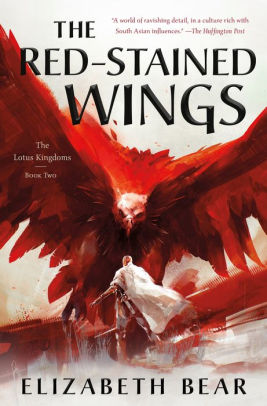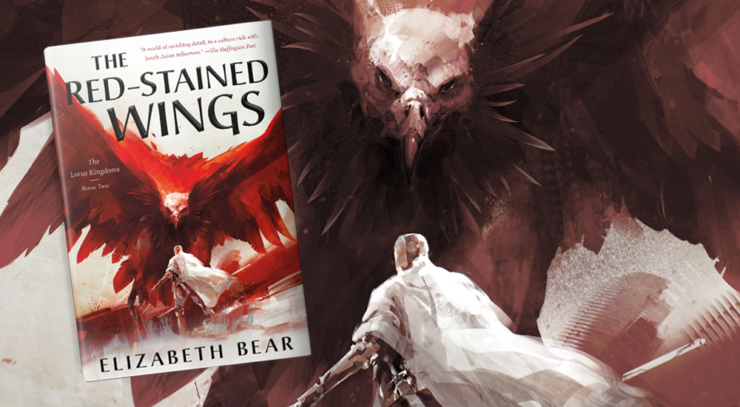Second in the Lotus Kingdoms trilogy and fifth novel set in the world of the Eternal Sky, The Red-Stained Wings kicks off immediately following the last scene of The Stone in the Skull (2017). At the opening of the novel, the Gage sets off across a poisoned desert to seek the solution to a Wizard’s riddle and the Dead Man remains behind with the rajni Mrithuri in a kingdom under siege. Meanwhile, Sayeh rajni is captive to one prince while her toddler son is captive to a second. War isn’t the most threatening thing on the horizon, though, as the machinations of gods—or worse—begin to creep through into human affairs under the cover of conflict.
As noted in discussion of the first book in the series, the Lotus Kingdoms trilogy is one large arc spread over three separate novels, which I particularly appreciate in a second-world setting as grand in scope as that of the Eternal Sky. Released from the constraint of wedging in a stand-alone plot for each novel, Bear devotes all of her considerable craft to weaving one dense, affectively powerful story. The result is well worth the gamble. In fact, I’d argue that the tension ratcheting up toward the conclusion of the overarching plot makes this one of the most gripping middle novels I’ve read in a long time.
Truly, as a whole, The Red-Stained Wings is exactly the sort of fare I expect from Bear at top form: a tight, engaging, richly-described novel that maneuvers with precision through a broad cast of characters spread over an even broader field of action, rife with mythos and intrigue. And it’s got a bit of humor to it, too. While it’s impossible to sketch out the twists and complexities of the developing plot in this space, suffice to say that it’s executed with skill from first page to last. That plot also has quite a bit to say, thematically, in terms of gender and power.
Buy the Book


The Red-Stained Wings
The novels of the Lotus Kingdoms are deeply invested in the struggles of women across a wide swath of ages, classes, faiths, and ethnic origins. Furthermore, questions of women’s access to prestige, power, and divine right within a patriarchal system are at the center of the political conflicts of these books. In the world of the text, culture clashes often illustrate Bear’s various approaches to representing womanhood on a political and personal level. For example, the Dead Man has a way of approaching women as divine as part of his faith which influences his sense of romance and duty with Mrithuri. The Wizards of varying schools often seem to exist outside of or in a sideways relation to gender roles as a rite of their sacrifices. However, the elderly poet-scholar Ümmühan uses with great craft and skill the trappings of femininity to do her artful work, as does Sayeh—purposefully, and with the awareness of how poorly men often treat women and how they can be manipulated thereby.
Across our rich cast of women, there is no one right way to present oneself or claim the space of womanhood. That is perhaps the best part of these novels, for me: there are so many women that it is impossible to reduce any one to a representative of the whole. Womanhood is a community shared by the nuns and the ranji, spymistresses and servants—and it does, of course, include trans women as well. Sayeh, middle-aged and brilliant and gorgeous, is forever thinking her way out of the terrible situation she has found herself in; she’s driven by her desire to save her son, her people, and also her cousin. Mrithuri is young and secure in her desire to never, ever be forced to the will of a man—an internal rebellion that the Dead Man is pleased to encourage with his own scriptures, confirming her suspicions about what sort of life she would lead if she were raja and to instead apply that as rajni.
Spoilers follow.
The question of divinity and women comes to a satisfying and well-foreshadowed head, too, in the climax of The Red-Stained Wings. Anuraja, the murderous misogynist and blasphemous prince seeking to conquer all of the Lotus Kingdoms, is—rather publically, after forcing Mrithuri into a state marriage with him—smited by the Peacock Throne the moment he takes a seat on it. He believed simply being a man gave him the right to it, as well as the right to rape and brutalize the women he meets, and is dealt a swift justice for his assumptions (either by the cursed throne or his own terrifying sorcerer). Bear manages to make this abrupt death scene immensely satisfying, because it’s well-supported as a possibility throughout the book that an unworthy emperor would die upon taking the seat—so when it happens, it feels simultaneously inevitable and shocking.
Sayeh, having been almost certain Anuraja would die taking his seat on the throne, has already built up companionship and loyalty among Anuraja’s men at arms that she employs in an instant gamble to coax them not to rebel. Her games are well played, and she does win them. Mrithuri, too, has had the bravery to hold her seat, leaving her the first Dowager Empress of the Lotus Kingdoms—which might be what’s needed to tackle a greater threat than war. Because that’s what’s been burgeoning at the edges of the distracting state conflict: something much, much more gruesome and significant.
On that note, Bear’s gift for description certainly lends itself to building a crawling horror around what the sorcerer(s) Ravana and Ravani are constructing: the necropolis throne in the destroyed city, the revenant corpses with coral sapphires for blood, animated entrails squishing across a stone floor, and so forth. It’s downright creepy, which was delightful to me. The anxious tension bubbling under the surface of the war surrounds this greater, more insidious danger. The turn this middle novel takes is then, ultimately, from human war to a struggle between gods moving players across the board as pawns. I’ve said it before and I’ll repeat it here: the Eternal Sky novels all excel at balancing the mythic against and alongside the human, creating an interwoven, vast cosmic struggle out of individual bodies and loyalties.
These struggles are grander than simple warring states though we care about those warring states, too, as a direct result of Bear’s facility at building her cast into real, unique people. Himadra, who has become a protagonist in his own right in The Red-Stained Wings, is perhaps one of the best examples of this. He’s a raja and in theory one of the enemies of our leading women in the first book, but he’s got some anti-royal and rather democratic sentiments of his own. And the whole “kidnapping” gambit doesn’t sit well with him, either. Sayeh and Mrithuri are unaware of his goals, as communication across armies and lands is more or less impossible aside from luck and directed messengers, but their meeting negotiations are the obvious thing I’m most anticipating in the final novel. (Plus, the Gage and a dragon in human form are about to be in his kingdom too.)
As with the first book, the part-two-of-three structure of The Red-Stained Wings leaves me grasping for more story at the last page. Bear’s pacing and plotting are superb; the characters are engaging, witty, flawed. It’s impossible not to feel drawn along with the tight flow of the narrative from one person to the next or one immense vista to another, such as the dragon’s dead city or the volcano-and-sorcery ravaged Ansh-Sahal. Grandiose second-world fantasies in this vein are rarely done so well and so accessibly. I’d recommend reading The Stone in the Skull and The Red-Stained Wings one after another for the greatest possible effect—and I’ll probably reread them again before the last book, too, to gulp it down as one big, breathtaking tale.
The Red-Stained Wings is available from Tor Books.
Read an excerpt from the novel here.
Lee Mandelo is a writer, critic, and editor whose primary fields of interest are speculative fiction and queer literature, especially when the two coincide. They have two books out, Beyond Binary: Genderqueer and Sexually Fluid Speculative Fiction and We Wuz Pushed: On Joanna Russ and Radical Truth-telling, and in the past have edited for publications like Strange Horizons Magazine. Other work has been featured in magazines such as Stone Telling, Clarkesworld, Apex, and Ideomancer.










